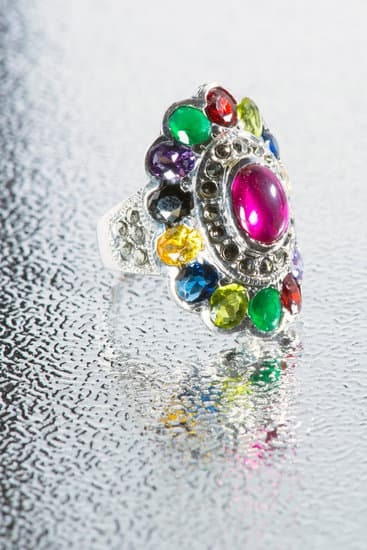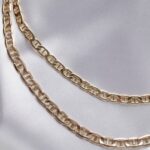Gold plated jewelry is a popular choice for its affordability and luxurious appearance. This introductory section of the article will provide readers with an understanding of what gold plated jewelry is and its historical background. We will explore the process of gold plating, the common metals used in this process, and delve into a brief history of gold plated jewelry.
Gold plating is a technique where a thin layer of gold is applied onto a base metal surface. This process involves electroplating or mechanical bonding to create an outer layer that mimics the appearance of solid gold. Common metals used for gold plating include silver, copper, brass, and nickel. The thickness of the gold layer can vary, ranging from as little as 0.175 microns to several microns.
The use of gold plating in jewelry dates back centuries, with historical evidence suggesting this technique was employed by ancient civilizations such as the Egyptians and Romans. Over time, it became a popular method for making jewelry more accessible – offering a way to enjoy the beauty of gold without the high price tag. With this background, let’s delve deeper into the topic by exploring why tarnish occurs on gold plated jewelry.
Understanding Tarnish
Tarnish is a common concern for jewelry enthusiasts, and understanding what causes tarnish on jewelry can help in preventing and addressing it. Tarnish refers to the gradual surface discoloration that occurs when metals react with certain elements in the environment, such as oxygen and moisture. In this section, we will delve into the factors that contribute to tarnishing and discuss how these elements affect gold plated jewelry.
Tarnish is essentially a chemical reaction between metal and certain compounds found in the air or on the skin. When it comes to gold plated jewelry, the underlying metal plays a significant role in how susceptible it is to tarnishing. While gold itself does not tarnish, the base metal used beneath the gold plating can corrode over time, leading to a dull appearance.
Oxygen and moisture are two main culprits behind tarnishing. When exposed to air, metals like copper or silver within gold plated jewelry can react with oxygen to form oxide compounds on their surface. These compounds often have different colors than the original metal, resulting in a discolored appearance.
Moisture can accelerate this process by creating a more conducive environment for oxidation to occur. Therefore, wearing gold plated jewelry during activities that promote sweating or exposing them to high humidity environments may increase their likelihood of tarnishing.
To minimize tarnishing of gold plated jewelry, it’s essential to take preventive measures and adopt proper maintenance routines. Storing jewelry away from moisture-prone areas like bathrooms or kitchens can help reduce exposure to excessive water vapor. Additionally, removing jewelry before engaging in activities that may cause sweating or exposing them to harsh chemicals can also prevent accelerated tarnishing.
Regular cleaning is another key aspect of maintaining gold plated jewelry’s appearance. Using gentle cleaning techniques such as using mild soap and warm water along with soft brushes or cloths can effectively remove dirt and oils without compromising the delicate plating layer. It’s important to avoid abrasive materials or harsh chemicals, as these can wear down the gold plating and increase the risk of tarnishing.
By understanding the causes and factors behind tarnish, individuals can make informed decisions about how to care for their gold plated jewelry. The next section will dive into determining the quality of gold plating and why thickness matters in preventing tarnish.
The Tarnish Myth
Addressing common misconceptions about gold plated jewelry:
- Gold plated jewelry is often mistaken for solid gold, leading to the belief that it will never tarnish. However, this is a misconception. Gold plated jewelry can indeed tarnish over time.
Debunking the belief that gold plating provides permanent protection:
- While gold plating does provide a layer of gold on the surface of the jewelry, it is important to understand that this layer is relatively thin. The thickness of the gold plating plays a significant role in preventing tarnish. If the gold plating is too thin or starts to wear off, the base metal may become exposed, making it susceptible to tarnishing.
Explanation on why gold plated jewelry may tarnish over time:
- There are several factors that contribute to tarnishing of gold plated jewelry. One of these factors is exposure to moisture and oxygen. When moisture comes into contact with the base metal beneath the gold plating, it can cause oxidation and lead to tarnishing. Oxygen also plays a role in accelerating this process.
To mitigate the risk of tarnish and extend the lifespan of gold plated jewelry, it is important for individuals to take proper care and maintenance measures. This includes avoiding exposure to harsh chemicals and abrasive materials, as they can damage both the base metal and the gold plating. Gentle cleaning techniques should be employed to remove any dirt or oils from the surface without causing damage.
Storing and protecting gold plated jewelry in a suitable environment can also help prevent tarnishing. It is worth noting that while these measures can greatly reduce the chances of tarnish, they do not guarantee complete prevention.
In summary, it is essential for consumers to understand that while gold plated jewelry does offer aesthetic appeal at an affordable price point, it is not immune to tarnishing. By being aware of its limitations and taking proper care and maintenance precautions, individuals can continue enjoying their gold plated jewelry while minimizing issues with tarnish.
Determining the Quality of Gold Plating
When it comes to gold plated jewelry, the thickness of the gold plating plays a crucial role in determining its quality and durability. The thickness of the layer of gold plating directly affects its resistance to tarnish and wear over time. In this section, we will explore why thickness matters when it comes to gold plating, standard measurements for gold plating thickness, and tips for assessing the quality of gold plated jewelry.
Gold plated jewelry consists of a base metal that is coated with a thin layer of gold through a process called electroplating. The base metal used can be varied, commonly including copper, silver, or brass. During the electroplating process, electric current is used to deposit a layer of gold onto the surface of the base metal.
The thickness of this layer varies depending on the quality and purpose of the jewelry piece. In general, a thicker layer will offer better protection against tarnishing and wear. The more layers there are, the longer the piece is likely to last before showing signs of wear.
Standard measurements for gold plating thickness are typically expressed in microns (µm) or millimeters (mm). A micron is equal to one-thousandth of a millimeter. The average range for gold plating thickness in jewelry ranges from 0.5 µm to 2.5 µm, although higher-quality pieces can have thicker layers.
Assessing the quality of gold plated jewelry involves examining its thickness and other factors such as its appearance and overall craftsmanship. If possible, inquire about the specific measurement or range of measurements for the gold plating thickness before making a purchase.
In summary, when it comes to gold plated jewelry, remember that thickness matters. A thicker layer of gold plating provides better protection against tarnishing and wear over time. Pay attention to standard measurements for gold plating thickness and assess the overall quality of the jewelry piece before making a purchase. By understanding the importance of thickness, you can make informed decisions and ensure that your gold plated jewelry lasts longer.
Caring for Gold Plated Jewelry
Proper care and maintenance are essential to keep gold plated jewelry looking its best and prolong its lifespan. While gold plating provides some protection against tarnish, it is still important to follow best practices to prevent damage and maintain the quality of your gold plated pieces.
To prevent tarnishing, it is crucial to avoid exposing gold plated jewelry to harsh chemicals such as perfume, lotion, or cleaning agents. These substances can strip away the protective layer of gold plating and cause discoloration or tarnish. It is also advisable to remove your gold plated jewelry before swimming or bathing, as chlorine and other chemicals in water can affect its appearance.
Regular cleaning is also necessary to keep your gold plated jewelry in top condition. However, it is important to use gentle cleaning techniques to avoid damaging the delicate layer of gold plating. One popular method is using warm water mixed with a mild soap solution. Dip a soft cloth or a toothbrush into the soapy water and gently scrub the jewelry. Be sure to rinse thoroughly with clean water afterward and pat dry with a soft cloth.
Storing and protecting gold plated jewelry properly can also contribute to its longevity. When not in use, it is recommended to store your gold plated jewelry in a separate pouch or box away from other metal pieces that may cause scratching or friction damage.
Avoid storing gold plated items in humid areas as moisture can accelerate tarnishing. If possible, consider using anti-tarnish strips or silica gel packs in your storage containers as they help absorb excess moisture in the air.
Table: Gold Plated Jewelry Maintenance Tips
| Maintenance Tips | Description |
|---|---|
| Avoid exposure to harsh chemicals | Perfume, lotion, cleaning agents, and other chemicals can strip away the gold plating. |
| Remove jewelry before swimming or bathing | Chlorine and other chemicals in water can affect the appearance of gold plated jewelry. |
| Clean gently with mild soap and warm water | Using a soft cloth or toothbrush, gently scrub the jewelry to remove dirt and grime. |
| Store in a separate pouch or box | Avoid scratching or friction damage by keeping gold plated pieces separated from other metals. |
| Avoid storing in humid areas | Moisture can accelerate tarnishing, so store your gold plated jewelry in a dry environment. |
By following these maintenance tips and taking proper care of your gold plated jewelry, you can ensure that it continues to shine and maintain its beauty for years to come. Remember that while some level of tarnishing may occur over time, regular cleaning and maintenance will help minimize its effects. Taking the time to care for your gold plated pieces will allow you to enjoy their elegance and style for a long time.
Extending the Lifespan of Gold Plated Jewelry
Gold plated jewelry can add a touch of elegance and sophistication to any outfit, but it requires some maintenance to keep it looking its best. By following a few simple maintenance tips, you can extend the lifespan of your gold plated jewelry and enjoy its beauty for years to come.
Avoid exposure to harsh chemicals and abrasive materials
Chemicals found in everyday products such as lotions, perfumes, and cleaning agents can accelerate tarnishing on gold plated jewelry. To prevent this, it is important to avoid direct contact with these substances. Make sure to apply lotions and perfumes before putting on your gold plated jewelry, allowing enough time for them to dry before wearing it. When cleaning your jewelry, use mild soapy water and a soft cloth rather than harsh chemicals or abrasive materials that could damage the plating.
Handle with care
Gold plated jewelry is more delicate than solid gold pieces, so it is important to handle them with care. Avoid exposing your jewelry to rough surfaces or objects that may scratch or chip the plating. When taking off or putting on your gold plated jewelry, do it over a soft surface such as a towel or velvet cloth to cushion any accidental drops.
Know when to seek professional re-plating services
Over time, the gold plating on your jewelry will naturally wear off due to regular use and contact with surfaces. To maintain its appearance and prevent tarnishing, you may need to have your gold plated jewelry professionally re-plated every few years. This involves removing the old layer of gold plate and applying a fresh coating.
To ensure optimal results, it is recommended to have this service performed by a reputable jeweler who specializes in plating services. They will be able to assess the condition of your jewelry and provide guidance on the best course of action.
By following these maintenance tips, you can help extend the lifespan of your gold plated jewelry and keep it looking beautiful for years to come. Remember that while gold plating provides an attractive and affordable alternative to solid gold, it does have its limitations. With proper care and maintenance, you can continue enjoying the beauty of gold plated jewelry while keeping it tarnish-free.
Alternative Options
Pros and Cons of Solid Gold
While gold plated jewelry offers a more affordable option for those who desire the look of gold without the hefty price tag, solid gold jewelry has its own advantages. One major benefit of solid gold is its durability. Solid gold does not tarnish or fade over time, making it a long-lasting investment. Additionally, solid gold holds its value and can be easily resold or passed down as heirlooms.
However, there are some downsides to choosing solid gold. The most obvious drawback is the cost. Solid gold jewelry can be significantly more expensive than gold plated pieces due to the high concentration of pure gold used in their composition. Depending on the karat weight, this can make a significant dent in your wallet.
Factors to Consider when Choosing Between Gold Plated and Solid Gold Jewelry
When deciding between gold plated and solid gold jewelry, there are several factors that you should take into consideration. One important factor is your budget. If you have a limited budget but still want to enjoy the aesthetic appeal of real gold, then gold plated jewelry may be the right choice for you.
Additionally, consider how often you plan on wearing the piece of jewelry. If it’s something you plan on wearing every day or for special occasions only, solid gold may be worth the investment. However, if it’s an accessory that you’ll only wear occasionally or for certain events, then opting for a more affordable alternative like gold plated jewelry could be a practical choice.
Lastly, consider your personal style and preference. Some individuals prefer the luxurious feel and look of solid gold jewelry, while others appreciate the variety and versatility that comes with having multiple options of affordable gold plated pieces.
Conclusion
In conclusion, gold plated jewelry can be a stunning and affordable option for those who want to embrace the beauty of gold without breaking the bank. However, it is important to understand that gold plated jewelry can tarnish over time. Despite common misconceptions, gold plating does not provide permanent protection against tarnish.
To determine the quality of gold plated jewelry, it is crucial to consider the thickness of the plating. Thicker layers of gold are more resistant to tarnish and will ensure a longer lifespan for your jewelry. It is recommended to look for standard measurements for gold plating thickness when purchasing jewelry.
Proper care and maintenance are key in extending the lifespan of your gold plated jewelry. Avoid exposing it to harsh chemicals and abrasive materials, and handle it with care to prevent excessive wear and tear. Regular cleaning using gentle techniques will help keep your gold plated jewelry looking its best.
While solid gold may be a more expensive option, there are pros and cons to both solid gold and gold plated jewelry. It ultimately comes down to personal preference and affordability considerations. When deciding between the two, it is important to weigh factors such as price differences and desired durability.
Frequently Asked Questions
How long will gold-plated jewelry last?
The longevity of gold-plated jewelry heavily depends on various factors, such as the quality of the plating and how it is cared for. Generally, gold-plated jewelry can last for a few months up to a couple of years before the plating starts to wear off.
However, it’s important to note that with regular use and exposure to different elements, the gold layer may gradually fade or tarnish. To prolong its lifespan, it is essential to avoid contact with harsh chemicals, perfumes, lotions, and excessive moisture.
Can I shower with gold-plated jewelry?
While it’s generally not recommended to shower with gold-plated jewelry, doing so occasionally might not cause immediate damage. However, exposing gold-plated pieces to water regularly can expedite the process of tarnishing and wear off the plating more quickly.
The combination of water and certain substances like body wash or shampoo can potentially affect gold-plated jewelry negatively. It is best to remove your gold-plated items before showering or swimming to ensure their long-term durability.
Is gold-plated jewelry good for everyday wear?
Gold-plated jewelry is typically not designed for everyday wear due to its delicate nature. Although it may seem appealing for daily use because of its affordability and aesthetics, continuous friction from clothing or physical activities can lead to accelerated wear and tear of the plating layer.
Additionally, exposure to sweat, oils from our skin, and environmental factors like humidity can impact its appearance over time. For more durable daily wear options, solid gold or gold-filled jewelry are recommended as they are made from higher-quality materials that can better withstand everyday use while maintaining their luster.

Welcome to my jewelry blog! My name is Sarah and I am the owner of this blog.
I love making jewelry and sharing my creations with others.
So whether you’re someone who loves wearing jewelry yourself or simply enjoys learning about it, be sure to check out my blog for insightful posts on everything related to this exciting topic!





